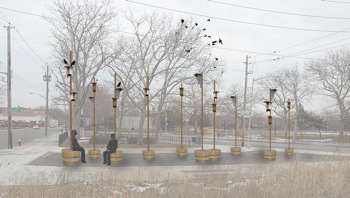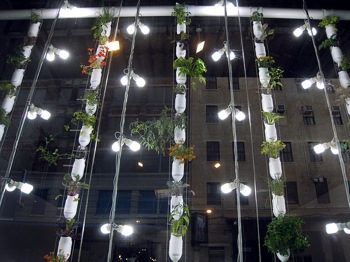
Atom Cianfarani, Sketch for "Welcomed Guests," 2009. Courtesy of the artist.
I closed Part 1 of this post with an e-mail from Truck Farmers Curt Ellis and Ian Cheney in which they encouraged others to reclaim unused open spaces in New York City.
Reclamation is central to the work of Brooklyn-based green artist/designer Atom Cianfarani who says, to paraphrase, that sustainable, recyclable designs can be beautiful, but few artists push it that far. (If you’re familiar with Brooklyn, Cianfarani helped to design the popular eco-eatery Habana Outpost in Fort Greene.) Later this week, DOT Urban Art Commission will host a ribbon-cutting ceremony for Cianfarani’s new public sculpture, Welcomed Guests, located across the street from Brooklyn’s Added Value/Red Hook Farm. (The 2.75 acre urban farm has provided space to stage and produce the sculpture). Sponsored by DOT and the Lower East Side Ecology Center, the piece consists of ten poles set in place by retired wine barrels from local vineyard & winery, Castello di Borghese. The poles will support functional bird homes made of salvaged materials; the roofs will be covered with patches of wild strawberries. These stylized habitats not only provide food to support birds, but also help native plants to flower and bees to pollinate. As illustrated in Cianfarani’s sketch, the space is also designed for humans to congregate, engage with urban wildlife, and, perhaps, have a snack of their own.
Welcomed Guests grew out of Cianfarani’s “gorilla” birdhouse project For The Birds (2008), for which she mounted 25 bird homes throughout Brooklyn. “DOT had several locations to select from,” says Cianfarni, “I chose this location for the site specific version because of the proximity to the farm and the water; I thought the combination would support some interesting species.” While Welcomed Guests primarily concerns man’s relationship with nature, Cianfarani’s engagement with the adjacent farm, as well as the community (where she resides) also deserves attention. Added Value/Red Hook Farm is widely recognized as a successful model of urban agriculture. According to their website:
For years, Red Hook was a textbook example of a broken food system and its effects on a community. Now, we are becoming a model of how residents, businesses, [etc] can come together with city, state, and federal government agencies and begin to rebuild a food system that promotes social interaction and economic activity while nurturing our health and improving the environment.
Though Cianfarani’s relationship to urban farming is tangential, Welcomed Guests serves as a point of entry into larger matters of human and environmental health, food inequality and urban revitalization. Taking her interaction with the Red Hook Farm and local community a step further, Cianfarani will lead a workshop at the farm (date TBD), teaching attendants how to use New York City garbage to construct their own birdhouses.

Britta Riley and Rebbecca Bray, "Window Farms," 2009. Installed at Eyebeam Art + Technology Atelier. Courtesy of the artists.
“Art reminds us of what’s at stake, helps us fully comprehend the issues, and teaches us how to adapt. But perhaps most important of all, art can inspire us to act, ”reads Grist.org. Pollan suggests that the greenest action one can take is to grow their own food. Artists Britta Riley and Rebbecca Bray have done exactly that with their project Window Farms—a vertically suspended, “hydroponic, modular, low-energy, high-yield edible food garden, built using low-impact or recycled local materials.” The artists built their first prototype during a residency this spring at Eyebeam Art + Technology Atelier, growing tomatoes, lettuce, beans, cucumber, okra, basil, arugula, kale and peppers along the way. Over the course of developing the prototype, Riley, Bray and other champions of the project came up with mini, portable, reservoir and other versions of the farming system to fit various budgets and spaces. Earlier this month, an impressive 13 x 13-foot Window Farm (Flavinesque and Sci-Fi unlike any farm I’ve ever seen) was installed in the storefront window of Eyebeam.
Seeking to create a diverse community of growers, Riley and Britta have released free How-to Manuals (download PDFs here) with the hopes that Window Farms will catch on in New York City, creating “a network of urban food production.” This project resonates not only with the budding interest in urban farming, but also, I think, with the current economy that has made many people more cognizant and cautious when it comes to finances. That is to say, why pay and depend on someone else when you can D-I-Y (or as Riley and Bray suggest, R&D-I-Y)?
Like the Victory Gardens of the early to mid-20th century (marketed through broadsides like the one atop my first post), the projects outlined here empower growers, eaters and viewers–especially those living in less than ideal conditions (recession, poverty, poor health, etc)–while also fostering a sense of community. At the same time, for these artists, the “usefulness” of their work is, as Art21’s Marc Mayer proposed in a recent comment, “not without consideration of beauty and form.”
Cheney and Ellis’s final film, scheduled for release this winter, will document other New York City farming experiments including Window Farms. Welcomed Guests will be installed for one year.




Pingback: Reader August 26, 2009 « updownacross